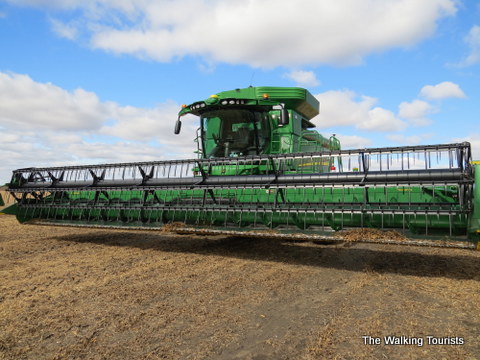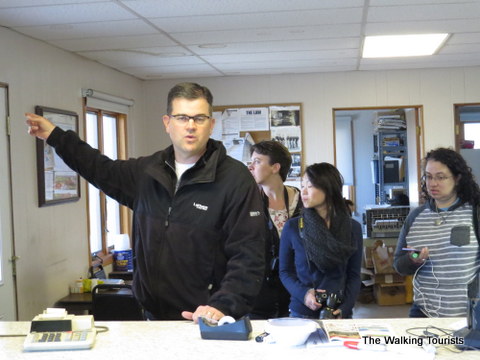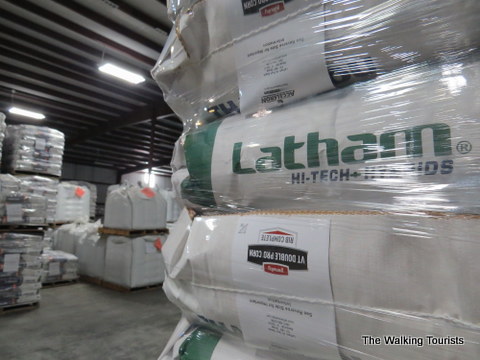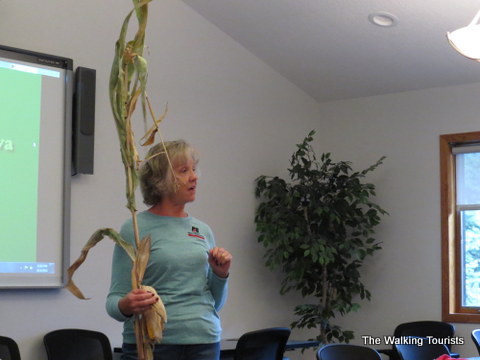North Iowa ag industry highlights advancements in farming

Agriculture is easily the top industry in North Iowa’s Franklin County. Farm fields dot the landscape, with soybeans and corn the main crops.
We received a close-up look into some agriculture operations during our visit to the county as part of a bloggers event. We got to see how farmers manage their fields to ensure there is enough soil for planting, as well as a look at harvesting and the processing of crops.
If the water levels are too high, fields flood. Farmers will not be able to plant seeds and manage the crops’ growth. In order to combat high water levels, they will often utilize “Tiling.” It’s basically a system of drainage pipes that allow water to seep in to the pipes and eventually flow to creeks and rivers. Ultimately, all water from this region ends up in the Gulf of Mexico via the Mississippi River.
In the early days, farmers used clay pipes, said Roy Arends. Roy and his family have farmed for several decades. The main line for Tiling is about 42-48 inches in diameter, he said. The smaller pipes can be 8-10 inches in diameter. The water in the soil would seep in to the pipes at the connection points.
Today, plastic drainage pipes are used, Roy said. The pipes have slits on top, which allow water to drip in easier.
His family has plowed the land to lay the pipes. They dig a few feet deep, so the pipes will be safe and allow for a reasonable water level. The drainage pipes are laid about every 100 feet in a field. Ropy and his family don’t work all of their digging. He will hire professional crews, which can usually complete the project quicker.
Once the land is managed, farmers should be able to raise crops.
We received rides in combines. That was pretty fun.
In case you don’t know, combines and tractors are not the same thing. Tractors are basically to haul things around with. Combines are used for harvest. Combines can be used to harvest corn or beans. In our case, we rode a combine that was being used to harvest beans.
The technology in tractors and combines is truly amazing.
My dad, who grew up on a farm, once told me about using a horse to pull the plow. Then, they added a second horse, and he was impressed with the improvement in time working the fields. Then, when they bought their first John Deere tractor, he thought he was in heaven. It was like night and day, he said.
Today, the equipment is operated via GPS. A farmer loads his information into the system, and the combine basically drives itself through the field, harvesting the crop. As we drove the rows we were harvesting, Roy was able to monitor the number of bushels being yielded, as well as the moisture content of the beans. The goal is to have the moisture level in soybeans at 11-14% for market.
The tractor was programmed the same way for driving. Roy’s son, Drew, followed us, with Lisa in his vehicle. At the end of my ride, Lisa and drew took over the combine, while Roy and I were in the tractor. During Lisa’s ride, Drew dumped a load of soybeans into the trailer trailing the tractor.
Some of the other bloggers headed to the Plagge farm, where they rode in a case/International Harvester combine. Case/IH vehicles are red. John Deere uses green.
The “heads” are different for each crop being harvested. They are interchangeable for a combine. Soybean harvest “heads” use a revolving reel with plastic or steel teeth. For corn, the head is angled downward.
Once the crop has been harvested, it’s market time. Farmers take their crops to the elevators.
Which leads me to our next stop on the road to a successful harvest.
Latham Hi-Tech Seeds is located in Alexander, Iowa. The company develops and markets hybrid seeds to help build better crops and stronger yields.
The family-owned seed plant has been in business for seven decades. Willard and Evelyn Latham started the company in 1947. Willard retrofitted some old equipment to help area farmers clean and preserve oats.
In 1951, he opened a plant on their property. The original Latham house is the company’s headquarters building, said John Latham, president of the company. The building has been renovated over the years, he added.
John is the third generation of the family to be involved with the company’s leadership. His dad and uncles became involved in the 1960s. While the company started with cleaning and preserving oats, it’s grown to include soybeans, corn and alfalfa, John said.
In the mid-1970s, the company added a sales force. While a small company with about 50 employees, it serves seven states. Its main base includes Iowa, Nebraska, Minnesota, Wisconsin, North Dakota and South Dakota. It does reach into northern Illinois, John said.
The seed company can see up to 500,000 bushels of soybeans during harvest, John said. Each truckload is inspected by hand, he said. The company feels strongly about having each truck personally inspected, as it helps weed out bad seed, John said. Seed not used by the plant is sold in town for feed.
Once a truckload passes inspection, the seeds are loaded into grain bins. Latham targets 11-14 percent moisture in its beans, John said. They are then processed through the plant. Each seed gets cleaned three separate ways, John said. The seeds are packaged in bags, sacks or bags.
A bag of soybeans will contain about 140,000 seeds. A bag of corn will have about 80,000 seeds. A robotic stacker can stack up to 60 bags at a time.
After becoming market ready, the seeds are sold to farmers/growers for the next season. Latham Seeds has worked area farmers for so long that some operations are on their fifth generation.
Following our education in agriculture in the field and at the elevator, we learned even more in a classroom environment. Or, we learned what goes in classrooms with “Ag in the Classroom,” presented by the North Iowa Farm Bureau offices.
Brenda Adams and Linda Anderegg demonstrated some lesson plans during a lunch session at Latham Hi-Tech Seeds.
They explained they meet with elementary students in 27 schools for 40 minutes each annually. Most of the students remember what they learned in kindergarten, Brenda said.
They discuss the importance of agriculture in their lives. For instance, they break down the amount of top soil the United States has to farm and produce enough crops and food to feed the world. She took an apple and used it as a model for the earth. After removing the amount of the planet that is water, it left about an eighth of the apple. She pared it down even more, based on land unsuitable for farming. In the end, about 1/32nd of the Earth can be used for farming. That, she said, is why we must care for the soil.
One thing a few people learned (not pointing you out, Lisa) is that corn stalks naturally produce one ear of corn each.
We were very grateful to learn a lot of information in a short time about the importance of agriculture and its impact on a local economy.
North Iowa is proud of its agriculture influence, and it should be. We appreciated the opportunity to see it firsthand. So, next time you take out the frozen vegetables for dinner, or cut into that steak at a restaurant, just remember, it starts with a farmer.
















